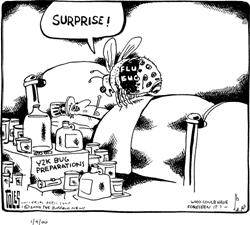More
to Come From the Flu This Season, Experts Say
By
Lawrence
K.
Altman, the New York Times
December 17, 2003

The full impact of this season's influenza is yet to be felt, particularly
in the East, federal health officials said yesterday.
"We are probably in for a fair amount
of activity yet to come over the next weeks," Dr. Stephen M. Ostroff,
a senior epidemiologist at the Centers for Disease Control and Prevention
in
Atlanta
, said in a telephone news conference.
Most of the 24 states reporting widespread
influenza are in the West, and Dr. Ostroff noted that "in many
relatively severe flu years, approximately two-thirds of the states will
be reporting widespread activity."
He did not say, however, that this would
necessarily be a severe season, and Health and Human Services Secretary
Tommy G. Thompson said in the same news conference that "we are
hoping that we have got the worst behind us because it started
early."
Dr. Ostroff added, "How it will play
out over the next couple of months remains to be seen."
The uncertainty is not limited to where
influenza will strike. The virus also changes so frequently that
scientists have to alter almost yearly the vaccine to protect against it.
Scientific committees make educated guesses about the choice of the three
strains of influenza virus used in each year's vaccine.
They were unable to include
Fujian
A, the strain that is widespread in the West, in this year's vaccine,
because it was detected too late for production. The current vaccine's
effectiveness has not been determined.
Manufacturers play a similar guessing game
in deciding how much vaccine to produce. For the past five years, they
have had a surplus because demand was lower than expected.
Last season, manufacturers produced 95
million doses, "but they lost money because they threw out 12 million
doses of the vaccine," Mr. Thompson said.
Also, he said, fewer companies have been
making vaccines for influenza and other diseases because vaccines are not
very profitable.
This season's demand appears to have outrun
supplies. One reason is that health officials and doctors have urged
people to be immunized in the event that SARS returns. While there has
been no known transmission of SARS since last summer, there is no test to
detect it in its initial stages, so doctors confronted with a patient with
respiratory disease might have trouble telling whether it is SARS or
influenza. If the patient is vaccinated against influenza, the thinking
goes, there might be less chance of confusion.
But critics have said that the government
and industry failed to consider the SARS factor enough in calculating the
87 million doses that were produced.
Mr. Thompson and other federal officials
said that because the vaccine is made in eggs, companies must buy the tens
of millions of them required months in advance and thus cannot increase
capacity after initial production has begun.
"It is not something you are going to
ramp up very quickly," Mr. Thompson said.
In an effort to avoid such imbalances in the
future, and particularly to prepare better for an influenza pandemic, Mr.
Thompson said he had requested $100 million from Congress. Of that amount,
he said his department had received $50 million for the fiscal year 2004
and was asking for an additional $100 million for the fiscal year 2005.
The money would be used to increase the
supply of eggs in the event of an epidemic and would also help scientists
in universities and industry develop more modern ways to prepare influenza
vaccines.
"Now that there has been so much
publicity about the flu this year," Mr. Thompson said, "I think
Congress is going to be much more willing to appropriate the necessary
dollars for us to go into the new technologies."
He said scientists were exploring two new
ways to make influenza vaccine.
One involves growing the virus in cells in
the laboratory. In theory, the technique, known as cell culture, will
allow manufacturers to quickly increase production if a strain not in the
current vaccine caused an epidemic.
The second, called reverse genetics, uses
genetic techniques to identify and isolate a particular strain so it can
be used more quickly to make a vaccine.
Critics have said that these techniques
could have been used to make this season's influenza vaccine if the
government and industry had invested in them in years past.
But experts said yesterday that many
scientific and legal obstacles needed to be overcome to use these
techniques to make a standard influenza vaccine.
Copyright
© 2002 Global Action on Aging
Terms of Use | Privacy
Policy | Contact Us
|



